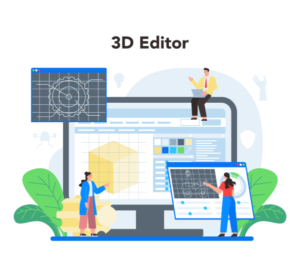Multimedia software has become an essential element of our daily lives. From creating engaging content to sharing it with the world, multimedia software has revolutionized the way we consume and interact with media.

The term “multimedia software” refers to computer programs that allow users to create, edit, play and share multimedia content, such as audio, video, images and animations. It enables users to create and disseminate digital content across a range of channels, including websites and social media platforms. Multimedia software is extensively used across a wide range of sectors, particularly entertainment, education, marketing and communication.
Statistics and challenges
The global multimedia software market overall is projected to have a growth rate (CAGR) of 11.1%. Within that market, the sector with the highest projected growth is the animation software market. It’s forecast to have a CAGR of 10.8%. This is followed by the audio editing software market at 7.3% and then the video editing software market at 5.6%.
Despite the indisputable and continued success of the multimedia software market, the sector does face some key challenges. Here are five of the main ones.
High development costs
Developing multimedia software requires specialized expertise, such as software development, design, and engineering skills. These skills are in high demand and companies must pay competitive salaries to attract and retain talent.
In addition, the development process for multimedia software can be lengthy and complex. It requires extensive research and development, including prototyping, testing and debugging. This can be expensive, as it requires investment in specialized hardware and software tools, as well as in dedicated testing and quality assurance resources.
Furthermore, the fast-paced nature of technological advancements, means that multimedia software companies are required to continuously invest in research and development efforts to keep their products relevant and competitive. This can pose a significant financial challenge, especially for smaller companies with limited financial resources.
Piracy

Piracy can take many forms, including illegal downloads, cracking and keygen software. Combatting it has long been a major challenge for the multimedia software industry, but some solutions offer businesses protection against piracy.
License key generation and management allow software companies to create unique license keys for each customer, making it more difficult for pirates to distribute illegal copies of the software.
Online activation requires users to activate their software using a unique code, which helps to prevent illegal copies from being distributed.
Rapidly changing technology
Rapidly changing technology means that products become outdated quickly. This results in shorter product life cycles, which can lead to reduced profitability and revenue for companies that are unable to keep up with the pace of change.
Furthermore, new technologies sometimes run the risk of being incompatible with existing software products. This can create additional challenges for multimedia software companies, as they must ensure their products are compatible with a wide and ever-changing range of devices and operating systems.
New technologies can also introduce new security risks and vulnerabilities, which must be addressed to protect users’ data and prevent malicious attacks. This can be a significant challenge for multimedia software companies, as they must continually monitor and update their products to ensure they are secure and reliable.
Competition
In addition to competing with each other, commercial multimedia software companies face competition from free and open-source software. These types of software are often developed by a community of developers who make their source code available to anyone who wants to use or modify it.
This makes it impossible for commercial software companies to compete directly on price as they have to charge for their products and/or services. Instead, multimedia software companies have to compete on overall value. Essentially, they have to persuade customers that the cost of their product/service is (more than) justified compared to the other options.
Changing user needs and preferences

A major change in user preferences is the increasing use of mobile devices. As smartphones and tablets become more prevalent, users expect multimedia software to be compatible with mobile platforms. Failing to offer mobile compatibility can cause companies to appear outdated and lose potential customers.
Another change in user needs and preferences is the demand for more intuitive and user-friendly software. With so many options available, users want software that is easy to use and understand, with clear and concise instructions. Companies that do not prioritize user-friendliness may find that users become frustrated and switch to more user-friendly alternatives.
Furthermore, users’ expectations for the features and functionality of multimedia software have also evolved. As technology advances, users expect more advanced features and tools to be included in their software. For example, presently more and more users are expecting embedded AI features into the multimedia programs they use. Companies must continually innovate and add new features to keep their products competitive and relevant.
Different types of multimedia software
Here are five of the most widely-used types of multimedia software:
Audio editing software:
This is a type of software used for recording, manipulating and processing audio files. It provides tools for editing, mixing and mastering audio tracks, as well as for adding special effects and enhancing the sound quality. Audio editing software can be used for a variety of purposes, such as music production, podcasting, sound design and post-production for film and video.
Examples of audio editing software include Audacity, Adobe Audition, Avid Pro Tools, ImageLine..
Video editing software:
This is a type of software used for editing and manipulating video files. It provides tools for importing, organizing and editing video footage, as well as for adding special effects, soundtracks and transitions to create a final product. Video editing software can be used for a variety of purposes, such as video production, filmmaking and online content creation.
Examples of video editing software include Adobe Premiere Pro, Final Cut Pro, DaVinci Resolve, AVS4YOU, Movavi, Muvee.
Image editing software:

This is a type of software used for manipulating digital images. It provides tools for importing organizing and editing images, as well as for adding special effects and enhancing the visual quality of the images. Image editing software can be used for a variety of purposes, such as graphic design, photography and digital art.
Examples of image editing software include Adobe Photoshop, GIMP and CorelDRAW.
Animation software:
This is a type of software used for creating animated content, including cartoons, movies, video games and other interactive media. It provides tools for designing, animating and rendering 2D and 3D graphics, as well as for adding sound effects, music and voiceovers to create a final product. Animation software can be used for a variety of purposes, such as animation production, advertising and education.
Examples of animation software include Autodesk Maya, Blender and Adobe Animate.
3D modelling software:

This category includes software used for creating 3D digital models of objects, characters, environments and other elements. It provides tools for designing, sculpting and texturing 3D models, as well as for animating and rendering the models for use in games, movies and other forms of media. 3D modelling software can be used for a variety of purposes, such as product design, architecture and special effects in film and video.
Examples of 3D modelling software include Autodesk 3ds Max, Maya, SketchUp and SolidWorks.
Trends, evolution, changes to expect, key developments in the market
The multimedia software industry has undergone significant growth and evolution, driven by a combination of technological advancements and changing consumer needs. The market is currently being heavily influenced by five major trends and they seem likely to continue to impact it in the future.
Artificial intelligence and machine learning
Multimedia software is benefiting from the incorporation of AI and ML, which are automating and streamlining various production aspects such as audio and video editing, animation and image processing. For instance, AI algorithms can automatically detect and remove background noise, as well as enhance colour grading in videos and audio. This advancement saves time and effort, increasing productivity and making it much easier to create high-quality multimedia content.
Virtual and augmented reality (VR/AR)

VR and AR are emerging as popular multimedia software trends. VR involves creating a computer-generated environment that enables users to interact with a virtual world as if they were physically present in it. AR, on the other hand, enhances the user’s real-world experience by overlaying digital information onto their physical environment. Both VR and AR technologies have potential applications across various industries, including gaming, entertainment, education and healthcare.
Multimedia software developers are creating solutions that can support VR and AR technologies. For example, 3D modelling software can be used to create virtual environments, while video editing software can be used to create 360-degree videos that can be viewed in a VR headset. Additionally, developers are creating software that enables users to create their own VR and AR content, such as apps that allow users to build their own augmented reality experiences.
Cloud-based solutions
The multimedia software industry, like the wider software industry, is witnessing an increasing trend towards cloud-based software solutions. This trend allows users to access multimedia tools from anywhere with an internet connection, promoting collaboration and file sharing while enabling software companies to provide regular updates and support without requiring users to download and install new software versions.
The move to Software-as-a-Service

The trend towards cloud-based solutions is enabling multimedia software companies to move away from selling software as a product and transition to a Software-as-a-Service (SaaS) model, which generates an ongoing stream of revenue instead of one-off purchases.
The growing importance of mobile
There has also been a significant increase in demand for mobile-based multimedia software solutions, as consumers increasingly use their smartphones and tablets to access multimedia content. This has led to a growing emphasis on user-friendly interfaces and intuitive workflows that work well on small screens.
In short
In conclusion, the future of multimedia software looks promising, with a growing market expected to reach billions of dollars in value in the coming years. The industry is constantly evolving, with key trends including the increasing use of AI and machine learning to improve the capabilities of multimedia software, the rise of cloud-based solutions and the ongoing battle against piracy.
As technology continues to advance and consumer demands change, it will be important for multimedia software companies to stay up-to-date and innovate in order to remain competitive. Overall, there is great potential for growth and innovation in this industry in the years to come.
The post The Future of Multimedia Software: Stats, Trends, and Innovations to Watch appeared first on The 2Checkout Blog | Articles on eCommerce, Payments, CRO and more.